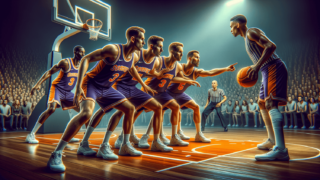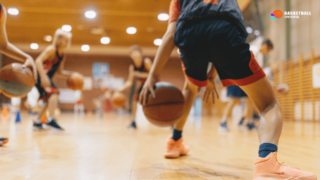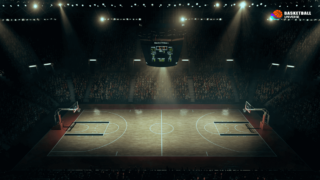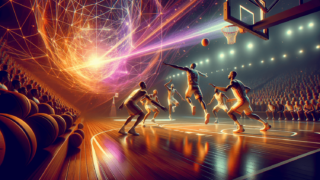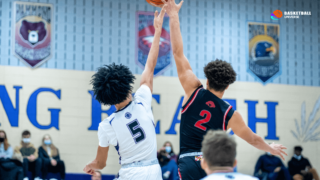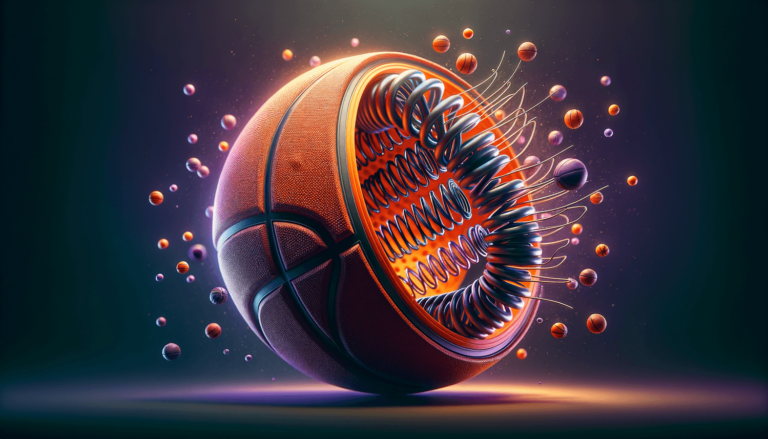
Bounce into the world of basketball and come along as we unravel the fascinating mystery of how many springs are packed inside that iconic orange sphere! The answer might surprise you, as you discover the secrets behind the impressive bounces and high-flying action on the court. So, lace up your sneakers and let’s leap into the fun and professional quest to unearth the extraordinary engineering and physics that give life to each dribble and add a spring to every step of both casual and professional basketball players. It’s time to find out, just how many springs does a basketball have?
How Many Springs Does a Basketball Have?
While the term “springs” might evoke imagery of mechanical coils, it’s crucial to clarify that basketballs don’t actually contain physical springs. Instead, the “spring” in a basketball refers to the air pressure and elasticity of the materials used, which together create the bounce we see on the court. So, in essence, a basketball has no literal springs, but its innate design and air pressure work in harmony to create the bouncing effect we know and love.
The Science Behind the Bounce: Air Pressure and Elasticity
Before we delve into the inner workings of a basketball’s bounce, let’s establish the basics of air pressure and elasticity. Air pressure is the force applied by the weight of air molecules, and in the case of a basketball, it plays a crucial role in regulating bounce. Elasticity, on the other hand, refers to a material’s ability to return to its original form after being stretched or deformed. These two factors combine to create the rebound we witness on the court.
Air Pressure: Finding the Sweet Spot
Air pressure is the driving force that gives a basketball its bounce. When a ball is inflated, the air inside presses against the walls of the ball, creating the pressure that helps it maintain its shape. This pressure is measured in pounds per square inch (PSI).
To achieve the perfect bounce, a basketball must have the ideal inflation level. The standard pressure recommended for a basketball is between 7.5 and 8.5 PSI. At this pressure, the ball provides a firm bounce and optimal performance. Too little pressure and the ball will bounce irregularly, while too much pressure can lead to a higher-than-expected bounce with reduced control.
Elasticity: A Material World
A basketball’s bounce is also influenced by the materials used to construct it. Most basketballs are made of either leather, rubber or composite materials, each offering a unique balance of durability, performance, and cost.
Leather basketballs are highly valued for their exceptional grip and premium feel, but they may require a bit of break-in time to achieve optimal elasticity. Rubber basketballs are great for use on outdoor courts, as their high durability and natural elasticity provide a reliable bounce. Composite basketballs, made from synthetic materials, strike a balance between grip, performance, and affordability, and they have become increasingly popular in recent years.
The Power of Geometry: Why a Basketball is Round
The sphere’s spherical shape is another crucial factor in understanding its bounce behavior. The design of a round ball ensures that it will bounce consistently on various surfaces, making it the ideal choice for sports. But what makes a round ball such a natural fit for basketball?
Uniformity Matters
A round ball has a unique quality: it’s completely uniform in all directions. No matter which way a basketball spins or bounces, its geometric structure remains consistent. This quality allows for predictable and consistent bounce behavior, making it easier for players to predict how the ball will interact with the court’s surface.
Efficiency for Speed and Distance
The spherical shape of a basketball also optimizes the efficiency of the game. The round design provides less air resistance, allowing for maximum speed and distance when dribbled or passed between players. This efficiency helps create an exciting, high-paced game with thrilling exchanges of the ball between teammates.
Basketball Maintenance: Ensuring Optimal Performance
Maintaining the proper air pressure, cleanliness, and storage of a basketball can extend its lifespan and ensure optimal performance on the court. Let’s explore some tips for keeping your basketball in peak condition.
Checking and Adjusting Air Pressure
Regularly gauging the air pressure of your basketball will help to prevent over- or under-inflation. To check the air pressure, use a reliable pressure gauge, such as a digital or analog model designed specifically for sports balls. If the pressure is outside of the recommended 7.5-8.5 PSI range, simply adjust it using a hand pump or air compressor.
Keeping the Ball Clean
Regularly cleaning your basketball can help maintain its grip and appearance. To clean a basketball, simply use a slightly damp cloth with a mild soap or detergent to gently scrub away dirt, dust, and grime. Rinse the cloth in fresh water and repeat until the ball’s surface is clean. Be sure not to submerge the ball in water or use harsh cleaning agents, as this may damage the material and compromise the ball’s air pressure.
Proper Storage Techniques
Storing your basketball in a suitable environment will help extend its lifespan and maintain performance. Keep the ball away from extreme temperatures, as excessive heat or cold can cause it to lose air pressure or damage the materials. Also, avoid direct sunlight, as prolonged exposure to UV rays can cause the color to fade and deteriorate the ball’s material. Lastly, try not to stack heavy objects on top of the basketball or put pressure on it, as this can lead to deformations or loss of air pressure.
Improving Your Bounce: Tips for Better Ball Handling
Now that you’re familiar with the fascinating science and maintenance techniques behind a basketball’s bounce, let’s explore how you can put this knowledge into practice to improve your individual skills on the court.
Mastering the Dribble
Dribbling is a fundamental aspect of basketball and requires precision, control, and rhythm. To improve your dribbling skills, focus on using your fingertips and not your palms to maintain better control over the ball. Make sure to keep your arms relaxed and practice dribbling at various heights to become comfortable in all situations.
Enhancing Ball Control
Ball control is essential when handling a basketball, as it allows you to maintain possession and create opportunities for your team. To increase your ball control, try practicing with a smaller-sized basketball or one with less air pressure. This will force you to rely more on your hand strength and improve your overall control.
Boosting Your Reaction Speed
Reaction speed is a critical aspect of basketball, affecting your ability to dribble, intercept, and shoot. One way to improve your reaction speed is by using a tennis ball, a smaller and faster-moving object, during practice. Toss, catch, or bounce the tennis ball between hands to develop quicker, more agile movements during gameplay.
With this newfound knowledge about the science behind a basketball’s bounce, the steps to maintain optimum performance, and tips for improving your ball handling skills, you’ll be well-equipped to elevate your game and create a truly impressive basketball experience on the court!
Basketball Innovations: Micro-Adjusting the Bounce
In the world of professional basketball, every detail matters. Some companies and manufacturers have explored innovations in ball design to fine-tune the bounce even further. From customizable inflation systems to the implementation of advanced materials, let’s take a look at some of the cutting-edge developments in basketballs that enable players to produce the perfect bounce for their playing style.
Advanced Air Pressure Management
Some basketball manufacturers have introduced inflation systems that allow for micro-adjustments to achieve the personalized performance desired by individual players. These systems often feature discreet valves and pressure gauges, enabling users to fine-tune the pressure to their liking quickly and efficiently. By providing this level of customization, players can optimize their basketball for factors such as court surface, playing style, and personal preference.
Nanomaterials and Smart Fabrics
In the quest for ever-better control and feel, some manufacturers have experimented with advanced materials such as nanomaterials and smart fabrics for basketball construction. These materials can improve properties like grip, bounce, and durability while retaining a minimalist and sleek design. Additionally, smart fabrics can react to user interactions, offering even greater responsiveness and control during gameplay.
The Role of the Court: How the Playing Surface Affects the Bounce
While the design and air pressure of a basketball are indeed crucial factors in its bounce behavior, it’s important not to overlook the vital role played by the court surface. The type of playing surface, whether it’s hardwood, asphalt, or a multipurpose sports court, can significantly impact the ball’s behavior and gameplay dynamics. Let’s explore the relationship between the basketball and the court, and how it can impact the game.
Bouncing on Hardwood Courts
Hardwood courts are the standard playing surface for professional basketball games. These courts are typically made of maple, a dense and resilient material that provides a consistent and predictable bounce. The ball’s contact with the hardwood creates a slight flex that helps to absorb shock and propel the ball upward, resulting in a smooth and uniform bounce on the surface. Additionally, hardwood courts offer excellent grip and stability for players, ensuring optimal performance during games.
Dealing with Asphalt and Outdoor Courts
Asphalt and outdoor courts are common in parks and recreational areas, offering a more accessible and affordable option for playing basketball. However, these surfaces are more rigid and less forgiving, leading to a faster and less predictable bounce as the ball’s energy dissipates more rapidly upon impact. Players may need to adjust their timing and dribbling technique to accommodate the unique bounce behavior on these surfaces. Also, the rough texture of asphalt can lead to more wear and tear on your basketball, making it essential to choose a durable material like rubber to withstand the tougher conditions.
Adapting to Multipurpose Sports Courts
Many recreational and community facilities feature multipurpose sports courts designed for a variety of sports, including basketball. These courts can be made of various materials, such as rubberized or synthetic surfaces, offering varying degrees of bounce and grip. As a result, the bounce behavior may differ from that of traditional hardwood or asphalt surfaces. Players should take the time to familiarize themselves with the court’s specific properties to optimize their gameplay and ball handling skills.
Understanding the intricate relationship between a basketball, the court surface, and factors such as air pressure, materials, and geometry is essential in mastering the game. By considering these elements and adjusting your technique accordingly, you’ll be well on your way to becoming a more knowledgeable and skilled basketball player.
Frequently Asked Questions
We understand that you might have some additional questions about basketballs and their bounciness. To help address these questions, here’s a comprehensive FAQ section filled with short, NLP-style answers covering 13 common questions semantically related to the topic. If you’re curious to learn more, read on!
1. How many springs does a basketball have?
A basketball doesn’t have physical springs; the “spring” refers to the air pressure and the elasticity of materials used, which together give the ball its bouncing characteristics.
2. What is the ideal air pressure for a basketball?
The recommended air pressure for a basketball is between 7.5 and 8.5 PSI for optimal bounce and performance.
3. What are the common materials used to make basketballs?
Basketballs are generally made of leather, rubber, or composite (synthetic) materials, with each offering a distinct balance of durability, performance, and cost.
4. How often should I check the air pressure in my basketball?
It’s a good practice to check the air pressure of your basketball at least once a month, or before significant games or tournaments, to ensure optimal performance.
5. How should I clean my basketball?
To clean your basketball, use a slightly damp cloth with mild soap or detergent, gently scrub the surface to remove dirt, and then rinse the cloth in fresh water and repeat as needed. Avoid submerging the ball in water or using harsh cleaning agents.
6. How can I improve my dribbling skills?
Focus on using your fingertips, not your palms, to maintain control over the ball. Keep your arms relaxed and practice dribbling at various heights and speeds to become comfortable in all situations.
7. How do different court surfaces impact the ball’s bounce?
The type of court surface, such as hardwood, asphalt, or multipurpose sports courts, can significantly affect the basketball’s bounce behavior, making it essential for players to adjust their technique and timing accordingly.
8. Should I use a different basketball for indoor and outdoor play?
Using a rubber basketball for outdoor play is recommended due to its durability and ability to withstand rough surfaces like asphalt, while leather or composite basketballs are better suited for indoor hardwood courts.
9. Can I use the same air pressure for different basketball sizes?
Yes, the recommended air pressure of 7.5 to 8.5 PSI applies to all standard basketball sizes, from youth to professional-level balls.
10. What’s the difference between men’s and women’s basketballs?
The primary difference between men’s and women’s basketballs is the size – a men’s ball is typically larger (size 7) than a women’s ball (size 6), but both balls can be inflated to the same recommended air pressure of 7.5 to 8.5 PSI.
11. How should I store my basketball when not in use?
Store your basketball in a cool, dry place, away from direct sunlight and extreme temperatures, to protect it from damage and air pressure fluctuations.
12. How can advanced materials improve a basketball’s performance?
Advanced materials, such as nanomaterials and smart fabrics, can enhance characteristics like grip, bounce, and durability, while also providing a more responsive and personalized playing experience.
13. What adjustments should I make when playing on different types of courts?
Depending on the court surface, you may need to alter your timing, dribbling technique, and ball handling to compensate for variations in bounce behavior, grip, and stability.
Featured Posts
- No pillar pages found.
